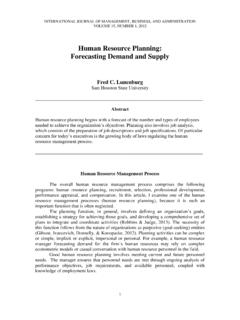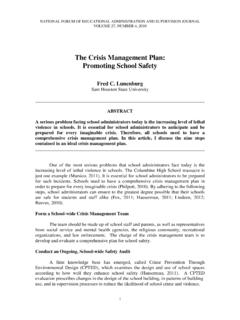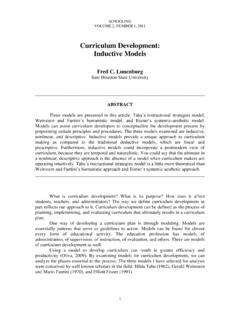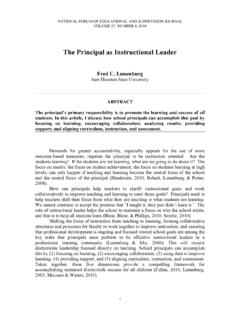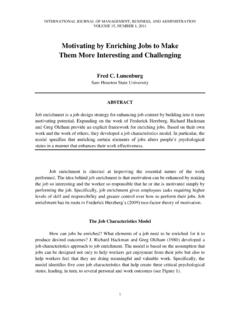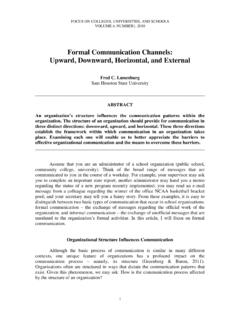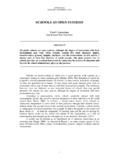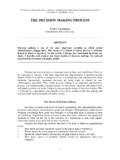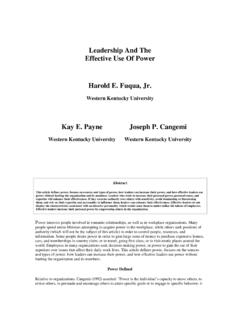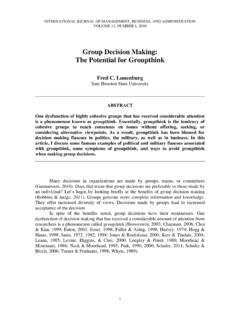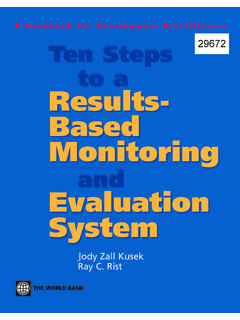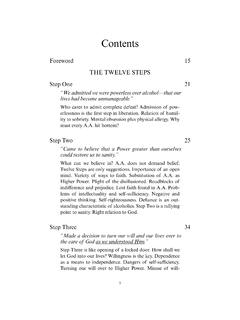Transcription of Approaches to Managing Organizational Change - …
1 INTERNATIONAL JOURNAL OF SCHOLARLY ACADEMIC INTELLECTUAL DIVERSITY VOLUME 12, NUMBER 1, 2010 1 Approaches to Managing Organizational Change Fred C. Lunenburg Sam Houston State University _____ ABSTRACT Much has been written about the nature of Change and the best methods to manage it. Based on the research, we now have a better understanding of the steps that must be taken to ensure that Change efforts have a significant and lasting impact. In this article, I discuss some of the most well known and popular models of the Change process. _____ After years of failed Change efforts, researchers are saying that knowledge of the Change process is crucial.
2 To succeed we need to cognize what we know about successful Change before and during the Change process. To this end, I will examine five of the most well known and popular models of the Change process: Lewin s three-step Change model, Kotter s eight -step plan, Harris s five-phase model, Fullan s Change themes set, and Greiner s six-phase process. Lewin s Three-Step Change Model Change involves a sequence of Organizational processes that occurs over time. Lewin (1951) suggests this process typically requires three steps: unfreezing, moving, and refreezing (see Figure 1). Figure 1.
3 Lewin s Three-Step Change Model. Unfreezing Moving Refreezing INTERNATIONAL JOURNAL OF SCHOLARLY ACADEMIC INTELLECTUAL DIVERSITY 2_____ This step usually means reducing the forces acting to keep the organization in its current condition. Unfreezing might be accomplished by introducing new information that points out inadequacies in the current state or by decreasing the strength of current values, attitudes, and behaviors. Crises often stimulate unfreezing. Examples of crises are demographic shifts in population, a sudden increase in employee turnover, a costly lawsuit, and an unexpected strike.
4 Unfreezing may occur without crises as well. Climate surveys, financial data, and enrollment projections can be used to determine problem areas in an organization and initiate Change to alleviate problems before crises erupt. Moving Once the organization is unfrozen, it can be changed by moving. This step usually involves the development of new values, attitudes, and behaviors through internalization, identification, or Change in structure. Some changes may be minor and involve a few members such as changes in recruitment and selection procedures and others may be major, involving many participants.
5 Examples of the latter include a new evaluation system, restructuring of jobs and duties performed by staff, or restructuring a department or entire organization, which necessitates relocating staff to different sites within the organization. Refreezing The final step in the Change process involves stabilizing the Change at a new quasi-stationary equilibrium, which is called refreezing. Changes in Organizational culture, changes in staff norms, changes in organization policy, or modifications in Organizational structure often accomplish this. Kotter s eight -Step Plan Building on Lewin s three-step Change model, John Kotter (1996) of Harvard University developed a more detailed approach for Managing Change .
6 Kotter began by listing common errors that leaders make when attempting to initiate Change . These included the inability to create a sense of urgency about the need for Change , failure to create a coalition for Managing the Change process, the absence of a vision for Change , failure to effectively communicate that vision, failure to remove obstacles that could impede the achievement of the vision, failure to provide short-term achievable goals, the tendency to declare victory too soon, and failure to anchor the changes into the organization s culture.
7 Based on these errors, Kotter proposed an eight -step process for Managing Change (see Table 1). FRED C. LUNENBURG _____3 Table 1 Kotter s eight -Step Process for Implementing Change Step Description 1. Establish a sense of urgency Unfreeze the organization by creating a compelling reason forwhy Change is needed. 2. Create the guiding coalition Create a cross-functional, cross-level group of people with enough power to lead the Change . 3. Develop a vision and strategy Create a vision and strategic plan to guide the Change process. 4. Communicate the Change vision Create and implement a communication strategy that consistently communicates the new vision and strategic plan.
8 5. Empower broad-based action Eliminate barriers to Change , and use target elements of Change to transform the organization. Encourage risk taking and creative problem solving. 6. Generate short-term wins. Plan for and create short-term wins or improvements. Recognize and reward people who contribute to the wins. 7. Consolidate gains and produce more Change The guiding coalition uses credibility from short-term wins to create more Change . Additional people are brought into the Change process as Change cascades throughout the organization. Attempts are made to reinvigorate the Change process.
9 8. Anchor new Approaches in the culture Reinforce the changes by highlighting connections between new behaviors and processes and Organizational success. Develop methods to ensure leadership development and succession. Note how Kotter s steps build on Lewin s model. Kotter s first four steps represent Lewin s unfreezing stage. Steps 5 through 7 represent Lewin s moving stage. The final step corresponds to Lewin s refreezing stage. Thus, Kotter s contribution provides leaders and Change agents with a more detailed guide for Managing Change successfully INTERNATIONAL JOURNAL OF SCHOLARLY ACADEMIC INTELLECTUAL DIVERSITY 4_____ Harris s Five-Phase Model Ben Harris (1975), formerly of The University of Texas, created a five-stage model for Managing Change (see Figure 2).
10 He stated that these phases come in a sequential order, but they often overlap one another. Each phase will be discussed briefly. Figure 2 - Interest, leadership, and progress in implementing Change . Legend II, LI, PI- End levels, unsuccessful program III, LII, PII- End levels, successful program X -Point at which leadership is misled by high interest Y -Point of crucial decision Crucial leadership investment Progress L e a d e r s h i p TIME SPAN V. Termination IV. Turning Point P II Finish Start L E V E L Low High I. Planning and Initiation L II II.
